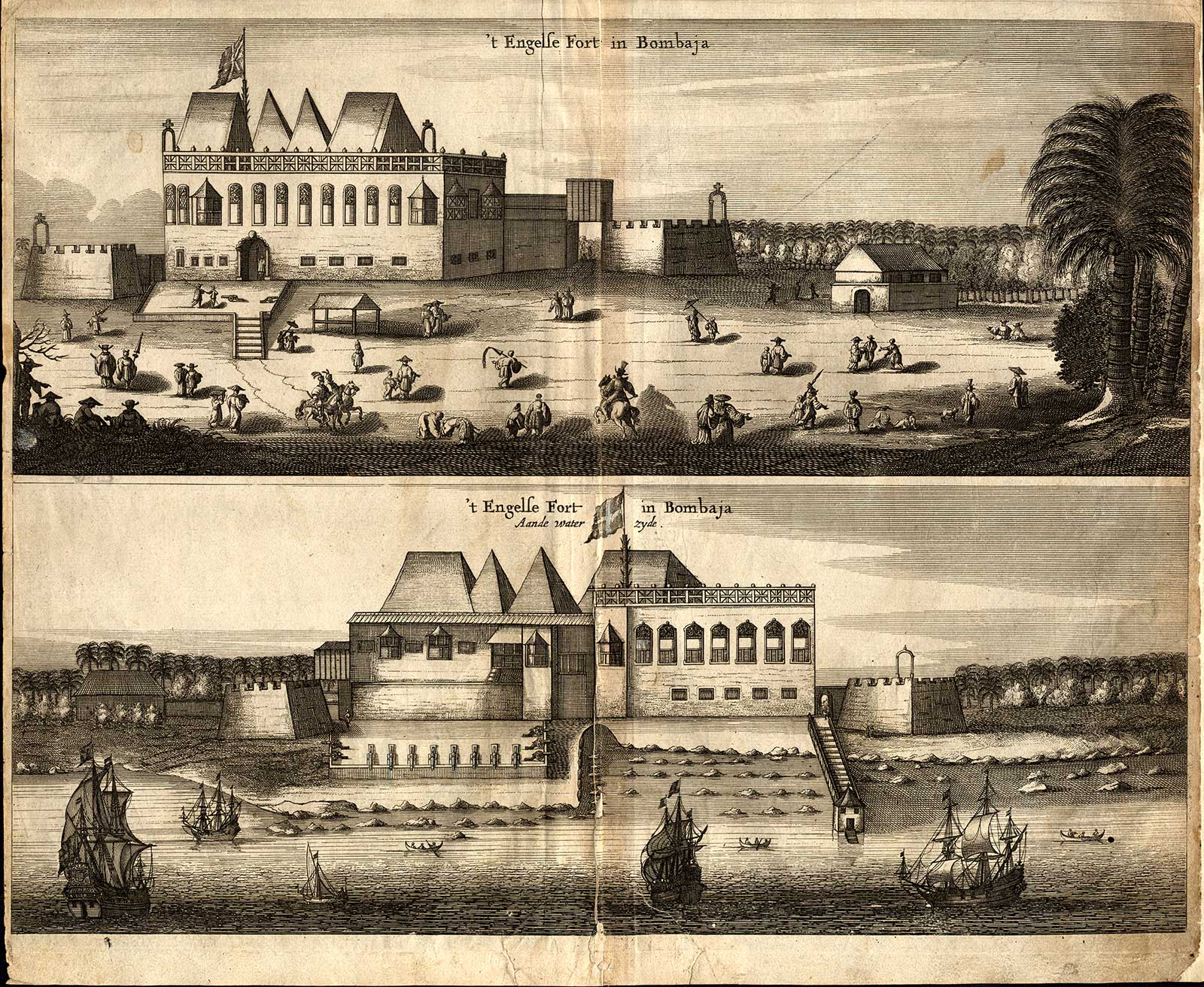
Views from the 1672 German edition of Baldaeus' 'Nauwkeurige beschrijving Malabar en Choromandel, derz. aangrenzend rijken, en het machtige eiland Ceylon,' by Philip Baldaeus, Amsterdam
Source: ebay, Aug. 2014
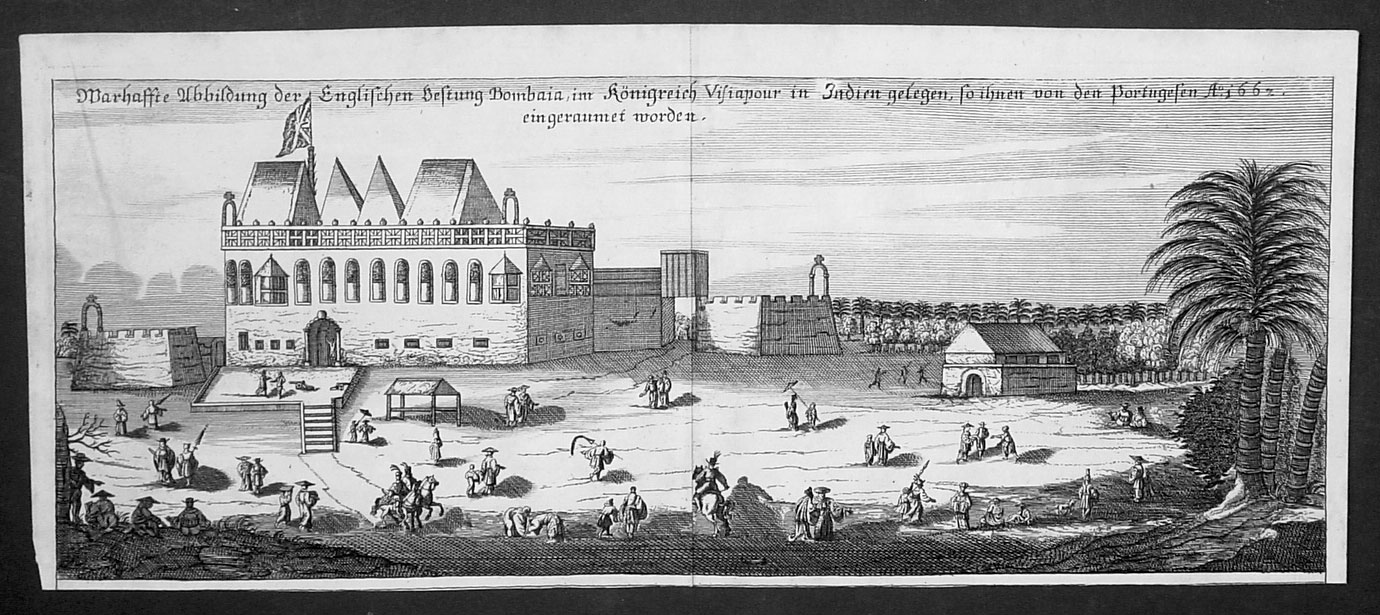
"Bombaia, in the realm of Visiapour": a view from 1703
Source: ebay, Nov. 2006

*"Bombay," an oil painting by George Lambert and Samuel Scott, c.1731* (BL)

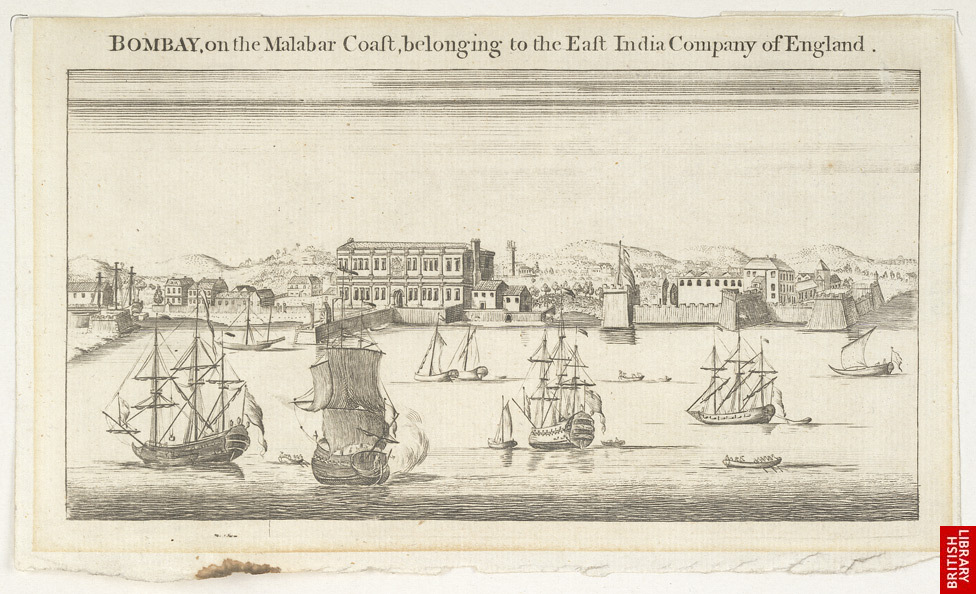
*Thana Fort on the Island of Salsette seen from the mainland; European figures in the foreground; by A. van der Heen, 1782* (BL) [*van der Heen 1782*]
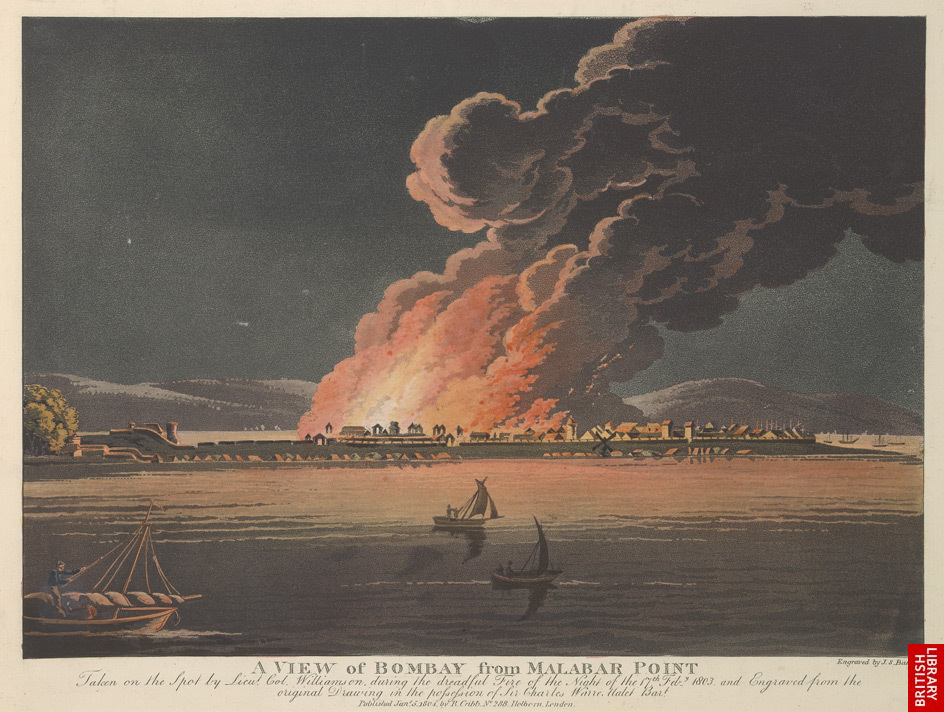
*A view of Bombay during the fire of 1803, an aquatint by J. S. Barth* (BL);
also: *The islands of Bombay and Salsette* [*Barth 1803b*]
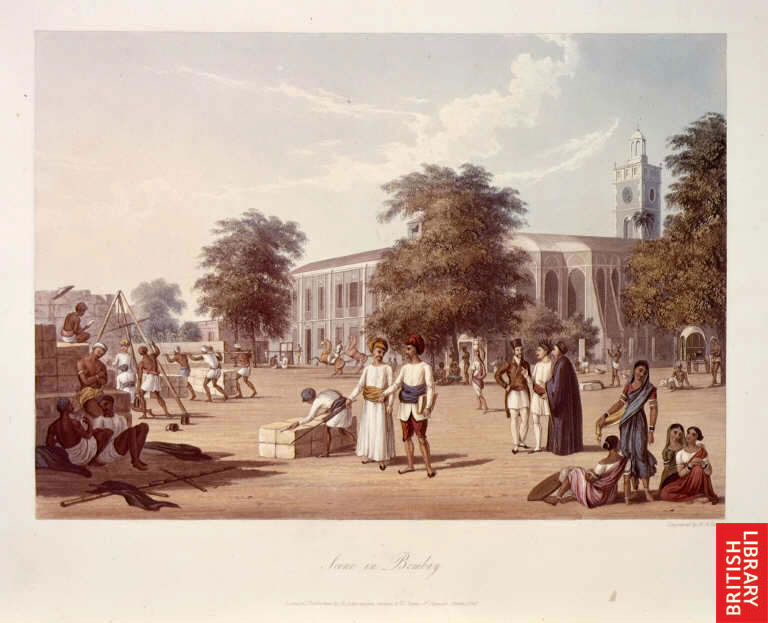
*"Scene in Bombay," by Robert Melville Grindlay and R. G. Greeve; London, 1826* (BL)
*"Bombay," from Meyers Universum, 1840*
Source: ebay, June 2006
*"Bombay Harbour: Fishing Boats, in the Monsoon," by Fisher, Sons, & Co., London, 1844*
Source: ebay, Dec. 2008
*"Landing at the Dockyard, Bander, of the remains of Lord Frederick Fitzclarence," Illustrated London News, 1855*
Source: ebay, Oct. 2010
*"Commencement of the Reservoir, in the Valley of Vehar, Island of Salsette," Illustrated London News, 1856*
Source: ebay, July 2009
*"The Hon. East India Company's fleet of transports and war-steamers in Bombay Harbour, previous to their departure for the Persian Gulf," Illustrated London News, 1857*
Source: ebay, Oct. 2009
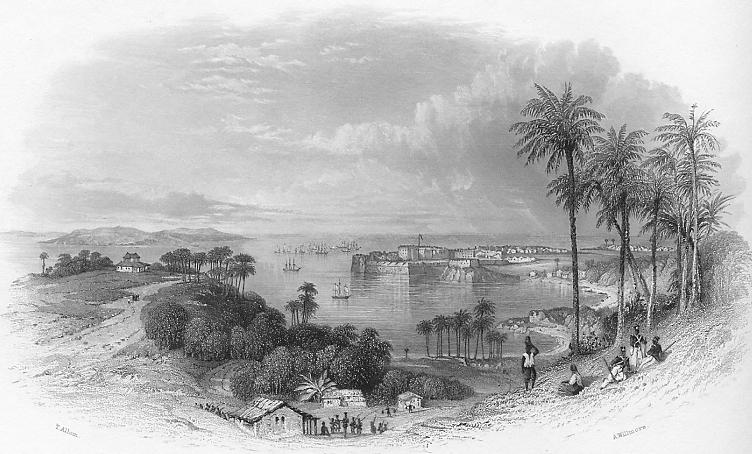
A steel engraving by Allom and Willmore (James S. Virtue Co., London, 1858)
Source: ebay, Sept. 2005
*"Native entertainment to European troops at Bombay," from the Illustrated London News, 1858*
Source: ebay, Aug. 2010
*"View of Bombay showing the fort," from 'History of the Indian Mutiny', 1858*
Source: ebay, Aug. 2007
*"Visit of the Viceroy of India to the Sassoon Dock at Bombay," from the Illustrated London News, 1865*
Source: ebay, Sept. 2009
*"Hindu women of Bombay in ceremonial dress," an engraving, 1866 (and later)*
Source: ebay, Oct. 2006
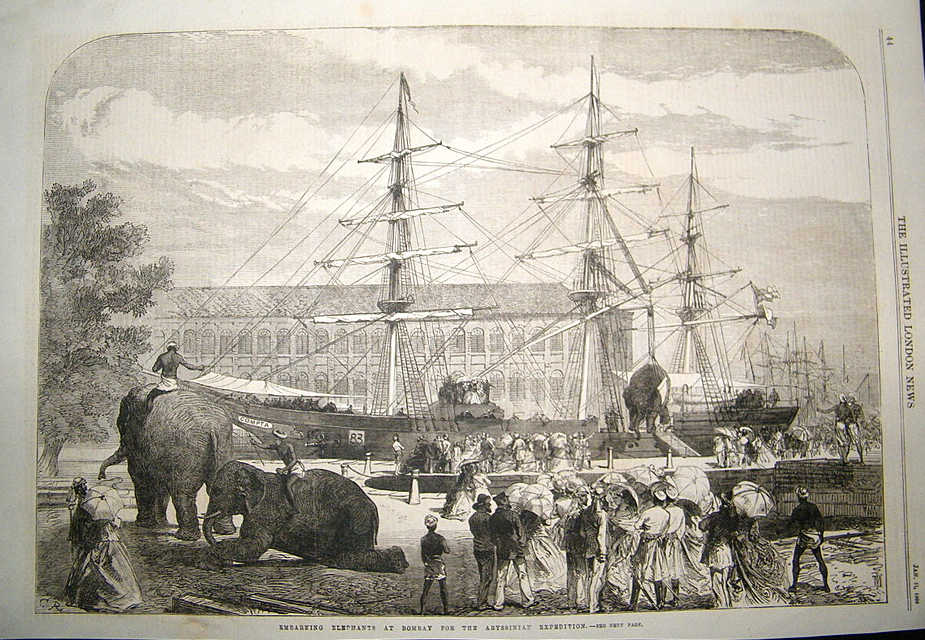
"Embarking elephants at Bombay for the Abyssinian expedition," from the Illustrated London News, 1868: very large scans of the *left half* and the *right half* of the engraving
Source: ebay, Jan. 2011
Source: ebay, Jan. 2006
*"Royal visit to India: Bombay: a banquet for the sailors of the fleet," from The Graphic, 1875*; also *"Ceremony performed by native girls at the Prince's landing, Bombay"*
Source: ebay, Jan. 2011

"Inhabitants of the Island of Salsette," a wood engraving from 1878; also: *"Hindoo women of Bombay in ceremonial dress"*; also *"A Hindoo Temple in the Black Town, Bombay"*; also *"Bombay Mussulmans"*
Source: ebay, Jan. 2007
*"Temple of Ambernath near Callian," a wood engraving by E. Therond, 1878*
Source: ebay, Jan. 2007
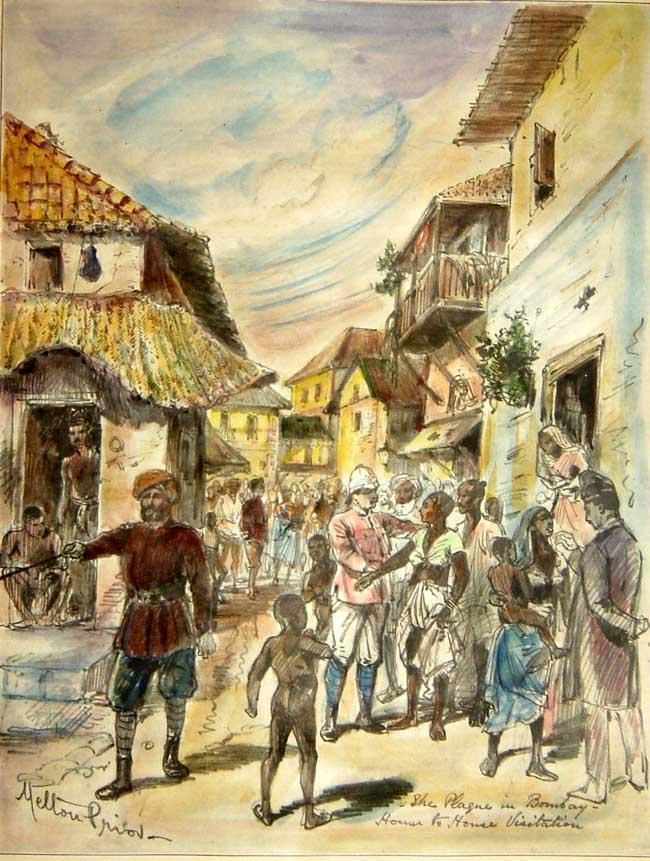
"The Plague in Bombay: House to House Visitation," from the Illustrated London News, 1898 (with modern hand coloring); also *"The plague at Bombay: Hindoos disposing of their dead at the burning ghauts" from The Graphic, 1897*
Source: ebay, Aug. 2006
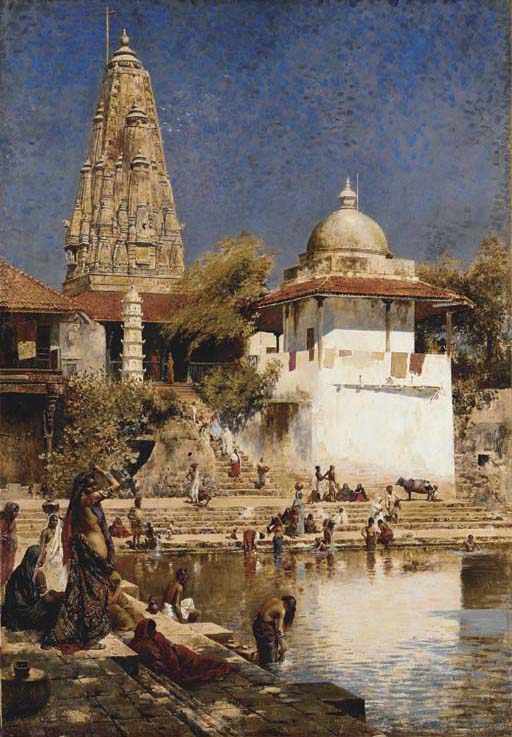
"The Temple and Tank of Walkeschwar at Bombay," by Edwin Lord Weeks, 1890's
Source: http://www.christies.com/LotFinder/search/LotDetail.asp?sid=&highlights=%3Cspan+class%3D%27esn%5Fsegment%27+title%3D%27%2FLotCommon%2FLotNotes%27%3Eupon+his+return+from+his+1892%2D93+expedition+to+%3Cb%3E%3Cspan+class%3D%27esn%5Fhighlight%27%3EIndia%3C%2Fspan%3E%3C%2Fb%3E%2E++During+that+expedition+Weeks+spent+some+time+in%3C%2Fspan%3E+%2E%2E%2E&intObjectID=4800779&AllObjectIDs=4794122,4793490,4793718,4795290,4802706,4799963,4799743,4799959,4799967,4799957,4803581,4801366,4801374,4801371,4801925,4801842,4796241,4802186,4800779,4800700&RefineQueryURL=AdvancedSearch%2Easp%3Fsid%3D%26entry%3Dindia%26T%3DLot%26P%3D%26CF%3D%26SU%3D1%26RQ%3DTrue%26AN%3D41
(downloaded Oct. 2006)
"Edwin Lord Weeks (American, 1849-1903). The Temple and Tank of Walkeschwar at Bombay, signed 'E. L. Weeks' (lower left); oil on canvas. 65¼ x 45 in. (165.7 x 114.3 cm.)
Lot Notes: This lofty, exotic and very beautiful canvas was probably executed in Weeks' Paris studio upon his return from his 1892-93 expedition to India. During that expedition Weeks spent some time in Bombay and the present painting can probably be identified as The Temples and Tank of Walkeschwar at Bombay, which weeks described as 'an effort to render the rich and deep tone characteristic of a tropical atmosphere at Bombay.' (Empire of India Exhibition, London, 1895, p. 213). This splendid work is indeed about 'atmosphere,' a spectacle of intense light and deep shade. The sun striking the brilliant white tomb is set off by the atmospheric density of the blue and aqua of the sky, creating a palpable suggestion of heat and haze of southern India.
The Walkeschwar Temples are clustered dramatically at the extreme edge of the promontory known as Malabar point. As with most of Weeks' great paintings, a significant part of the sweeping drama of the picture lies in its meticulously-calculated composition, in this instance a series of vertical layers, oblique to the picture plane, gradually receding from the foreground figures. The sharp diagonal of the foreground steps leads the eye to the partially disrobed female figure, which then leads to the mid-plane of the scene, where the subtle diagonal of the broad steps is countered by the narrower flight of stairs leading past the white-walled domed temple of Ganpati to the upper temple. Also reinforcing this middle-ground is the unifying sweep of the clay tile roofs. Finally, the background plane of the painting is defined by the towering stone gopura, or spire, of the Hindu temple of Rameshwar Shiva thrusting upward into the vastness of the sky.
In fact, the Hindu temple of Rameschwar Shiva was an unusual architectural element for Weeks to paint, as he usually confined himself to architectural backdrops of the Islamic srtuctures of north India. In the context of this southern painting, however, the Hindu gopura, makes complete sense, and its inclusion in the composition demonstrates Weeks' amazing deftness in constructing wholly accurate complex perspective views.
Opposing the complexity and precision of the architecture and figures is the cool still water of the pool, or tank, an excavated regular pool for ceremonial ablutions, often seen in India as adjuncts to temples and mosques. The handling of the water, like the 'mosaic' handling of the sky, also seen in other works of this period, betrays Weeks' interested exposure to impressionism. Although unusual in any form for an "academic" painter, Weeks' impressionist brushwork seems to have been less an intellectual exercise than a means of more suggestively rendering his subjects.... The Temple and Tanks of Walkeschwar at Bombay is an important painting from Weeks' mature period, in which a depiction of everyday life is ennobled in an academic vision of the greatest skill.
We are grateful to Dr. Ellen K. Morris for providing the catalogue entry for this work, which will be included in her forthcoming Weeks catalogue raisonné."